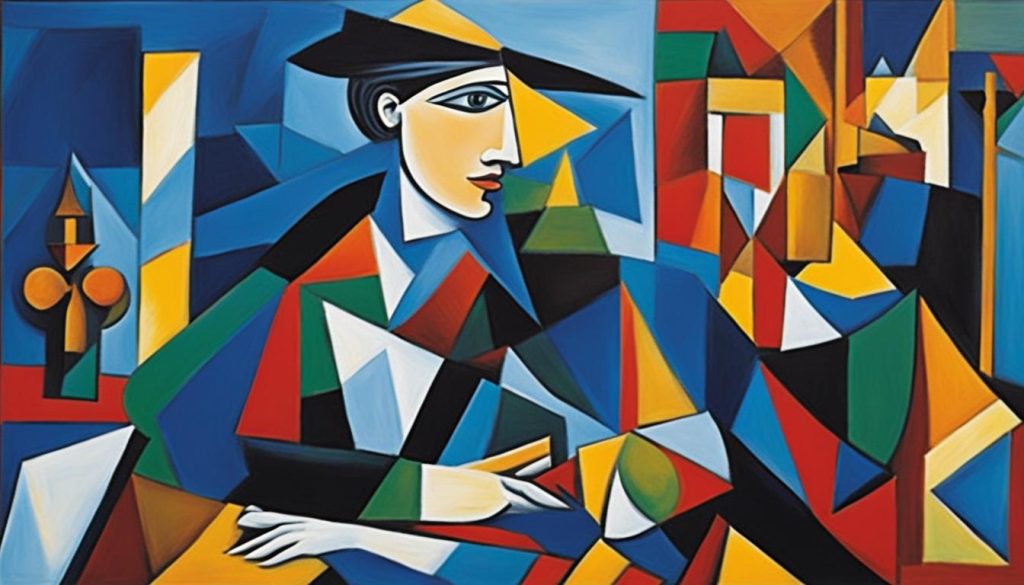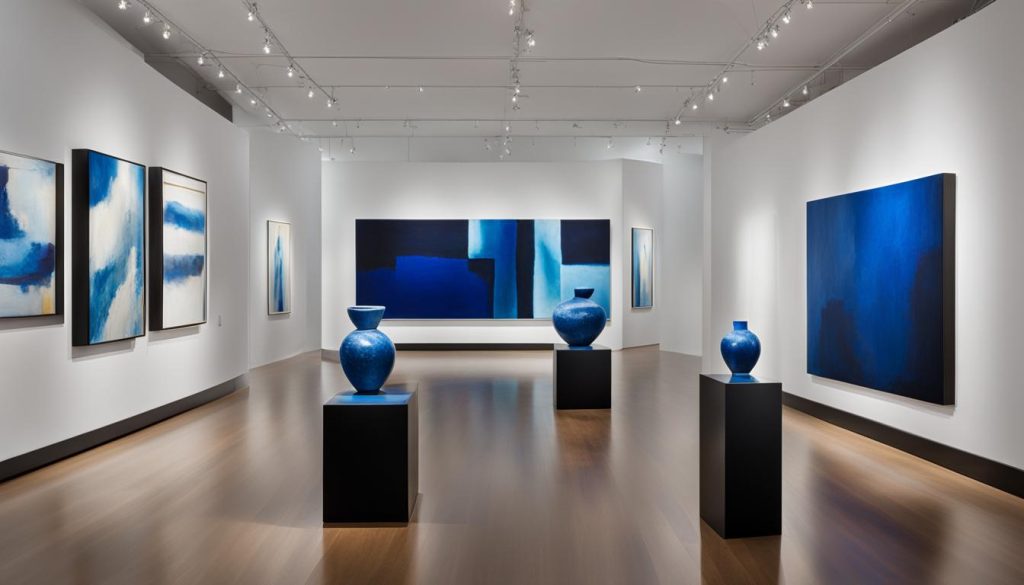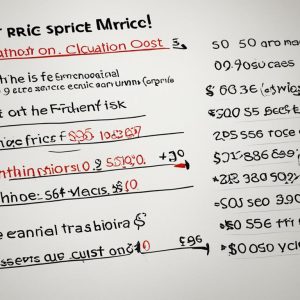Blue chip art refers to high-value artworks by well-established artists that have a solid reputation for increasing in value over time. These artworks are considered a safe option for art collectors and investors due to their history of success in the art market. Just like blue chip stocks in reputable and profitable businesses, blue chip artworks are known for their stability and potential for long-term capital growth.
Investing in blue chip art has become an attractive option for diversifying investment portfolios. With the average value of art steadily increasing, the blue chip art market has become more accessible to a wider range of investors. However, it requires patience and expertise, as it is considered a long-term investment.
Key Takeaways
- Blue chip art refers to high-value artworks by well-established artists.
- These artworks have a solid reputation for increasing in value over time.
- Blue chip art is considered a safe option for collectors and investors.
- Investing in blue chip art can be a viable option for diversifying investment portfolios.
- Patience and expertise are required when investing in blue chip art.
Blue-Chip Art vs Red-Chip Art
When it comes to the art market, there are two main categories that differentiate artworks based on reputation and market value: blue-chip art and red-chip art. Blue-chip art refers to established artists with a solid reputation and a history of success, while red-chip art encompasses emerging artists who are actively creating and gaining recognition in the art world.
Blue-chip artists have already established themselves in the market and often sell their artworks for high prices at prestigious auction houses. Their works are considered safe investments due to their proven track record of increasing in value over time. On the other hand, red-chip artists are relatively new to the market and may sell their pieces through online platforms or smaller galleries.
The blue-chip art market is known for its stability and predictability, while the red-chip art market can be more volatile and unpredictable. Blue-chip artworks are often seen as traditional and conventional, appealing to collectors and investors who prefer established names and a safer investment option. Red-chip art, on the other hand, offers an exciting opportunity to discover emerging talent and support artists at the early stages of their careers.
Blue-chip art refers to established artists with a solid reputation, while red-chip art encompasses emerging artists who are actively gaining recognition.
Blue-Chip Art vs Red-Chip Art Market
The blue-chip art market is well-established and has a long history of success. Blue-chip artists’ works are often showcased in renowned galleries and museums, attracting high-profile collectors and investors. The value of blue-chip artworks tends to appreciate steadily over time, making them desirable long-term investments.
In contrast, the red-chip art market is more dynamic and can experience rapid shifts in demand and prices. Red-chip artists’ works are often more affordable, making them accessible to a wider range of collectors and investors. However, investing in red-chip art carries more risks as the artists’ reputations and market demand are still evolving.
Both blue-chip and red-chip art offer unique opportunities for collectors and investors to engage with the art market. Blue-chip art provides stability and proven value, while red-chip art offers the potential for discovery and supporting emerging talent.
Examples of Blue-Chip Artists
Blue-chip artists are renowned for their exceptional talent and the enduring value of their artworks. Here are some famous blue-chip artists whose pieces have captivated art enthusiasts and collectors worldwide:
Andy Warhol
One of the most iconic figures in the art world, Andy Warhol’s works have become synonymous with pop art. His vibrant and thought-provoking creations, such as the famous “Shot Sage Blue Marilyn,” continue to fascinate audiences and fetch high prices at prestigious art auctions. Warhol’s unique style and exploration of popular culture have solidified his status as a blue-chip artist.
Jean-Michel Basquiat
Renowned for his expressive and dynamic paintings, Jean-Michel Basquiat’s art reflects his personal experiences and societal issues. His masterpiece “Untitled” showcases his raw talent and ability to blend various artistic influences into compelling compositions. Basquiat’s contributions to the art world have made him a highly sought-after blue-chip artist.
Keith Haring
Known for his distinctive style characterized by bold lines and vibrant colors, Keith Haring’s art carries powerful messages of activism and inclusivity. His iconic pieces, such as “Untitled,” epitomize his commitment to using art as a medium for social change. Haring’s contribution to the art world has cemented his position as a blue-chip artist.
Pablo Picasso
 Pablo Picasso’s immense talent and prolific career have left an indelible mark on the art world. As a pioneer of modern art, his innovative approach and remarkable versatility have resulted in countless masterpieces. Picasso’s artworks, like “Guernica” and “Les Demoiselles d’Avignon,” continue to inspire and hold significant value in the blue-chip art market.
Pablo Picasso’s immense talent and prolific career have left an indelible mark on the art world. As a pioneer of modern art, his innovative approach and remarkable versatility have resulted in countless masterpieces. Picasso’s artworks, like “Guernica” and “Les Demoiselles d’Avignon,” continue to inspire and hold significant value in the blue-chip art market.
These artists and their notable works represent the essence of blue-chip art. Their creations not only hold immense artistic and cultural value but also serve as valuable investments for collectors and art enthusiasts alike.
Investing in Blue-Chip Art
Investing in blue-chip art is a compelling option for collectors and investors looking to diversify their portfolios. Blue-chip artworks, created by renowned artists with established reputations, have a proven track record of increasing in value over time. This makes them an attractive investment proposition in the art market.
Blue-chip art offers a unique opportunity to own highly coveted pieces of art that not only provide aesthetic enjoyment but also have the potential for long-term financial gain. The demand for blue-chip art continues to grow, with collectors and investors eager to acquire works by artists such as Andy Warhol, Jean-Michel Basquiat, Keith Haring, and Pablo Picasso.
When considering investing in blue-chip art, it is important to understand the dynamics of the art market and the factors that influence the value of these artworks. Working closely with art market experts and advisors can provide valuable insights into market trends, artist reputations, and potential investment opportunities.
Blue Chip Art Investment Strategies
There are different strategies for investing in blue-chip art, depending on the investor’s goals and risk tolerance. Some investors opt to acquire individual artworks, while others choose to invest in art funds or participate in auction sales. Fractional ownership, where investors co-own a portion of a valuable artwork, is also gaining popularity.
It is crucial to conduct thorough research and due diligence before making any investment decisions. Understanding the provenance, condition, and authenticity of a blue-chip artwork is essential to ensure a sound investment. Working with reputable dealers, galleries, and auction houses can provide access to genuine artworks and expert advice.
As with any investment, investing in blue-chip art carries risks. The art market can be influenced by various factors, including economic conditions, art market trends, and shifts in collector preferences. However, blue-chip art has historically demonstrated its resilience in the face of changing market conditions, making it an appealing option for long-term investors.

| Advantages of Investing in Blue-Chip Art | Considerations for Blue-Chip Art Investors |
|---|---|
|
|
Printmaking and Blue-Chip Art
Printmaking plays a significant role in the world of blue-chip art, offering collectors and investors an accessible entry into the market. Blue-chip prints and editions allow art enthusiasts to own significant works by renowned artists at different price points. These limited quantities of prints often appreciate in value over time, making them an attractive investment option.
The blue-chip print market has gained popularity among collectors and investors, with artists like Andy Warhol and Roy Lichtenstein contributing iconic artworks that continue to captivate audiences. The demand for blue-chip art prints and editions remains strong, even during challenging market conditions. This segment of the art market has shown consistent growth, offering opportunities for collectors to acquire valuable pieces that can potentially increase in value.
To better understand the significance of blue-chip art prints and editions, let’s take a look at the following table that highlights some notable examples:
| Artist | Artwork | Edition Size | Current Market Value |
|---|---|---|---|
| Andy Warhol | Marilyn Monroe (Marilyn) | 250 | $100,000 |
| Roy Lichtenstein | Whaam! | 300 | $150,000 |
| Keith Haring | Untitled (Radiant Baby) | 500 | $75,000 |
Table: Examples of blue-chip art prints and editions
As shown in the table, blue-chip art prints and editions have varying edition sizes and market values. These factors contribute to the overall desirability and investment potential of these artworks. Collectors and investors should carefully consider the edition size, artist reputation, and market demand when making decisions in the blue-chip print market.
Contemporary Artists and Blue-Chip Art
Contemporary blue-chip artists continue to shape the art market with their innovative and thought-provoking creations. They bring a fresh perspective and push the boundaries of traditional art forms, attracting collectors and investors alike. These artists experiment with various mediums, including painting, sculpture, installation, and digital art, reflecting the evolving trends and interests of the art world.
One notable contemporary blue-chip artist is Yayoi Kusama, known for her vibrant and immersive installations. Her works, such as the “Infinity Mirror Rooms” and “Polka Dot” series, have captivated audiences and fetched high prices at auctions. Kusama’s ability to merge art with the immersive experience has made her a sought-after artist in the blue-chip art market.
“Art is the meeting point of the world inside and the world outside.” – Yayoi Kusama
Rising stars like KAWS and Takashi Murakami have also made significant contributions to the contemporary blue-chip art scene. KAWS, known for his cartoon-inspired characters, has gained a dedicated following and collaborated with major brands. Murakami’s iconic Superflat style and fusion of Japanese pop culture have made him an influential figure in the art world.
As the blue-chip art market evolves, it is essential to stay informed about the trends and works of contemporary artists. Their unique perspectives and innovative approaches offer valuable insights into the changing landscape of the art market. Whether it’s through exhibitions, gallery showcases, or online platforms, the work of contemporary blue-chip artists continues to shape the future of the art world.
Conclusion
Understanding blue chip art is essential for art collectors and investors looking to make informed investment decisions. Blue-chip artworks by renowned artists such as Andy Warhol, Jean-Michel Basquiat, Keith Haring, and Pablo Picasso have a solid reputation for increasing in value over time. Investing in blue-chip art offers the potential for long-term capital growth and diversification of investment portfolios.
The blue chip art market analysis shows that prints and editions of blue-chip artworks provide accessible entry points into the art market. These limited quantity prints appreciate in value and allow collectors to own significant works by famous blue-chip artists at different price points. Printmaking has gained popularity, and artists like Warhol and Roy Lichtenstein have contributed significantly to the print market with their iconic artworks.
For collectors and investors, staying informed about market trends and the works of contemporary blue-chip artists is crucial. The demand for contemporary blue-chip art is driven by collectors seeking unique and valuable pieces. By understanding blue chip art and its market dynamics, individuals can make strategic investment decisions and potentially benefit from the appreciation of these high-value artworks.
FAQ
What is blue-chip art?
Blue-chip art refers to high-value artworks by well-established artists that have a solid reputation for increasing in value over time.
How does blue-chip art differ from red-chip art?
Blue-chip art refers to artworks by established artists with a history of success, while red-chip art refers to art by emerging artists who are actively creating work.
Who are some examples of blue-chip artists?
Blue-chip artists include well-known names such as Andy Warhol, Jean-Michel Basquiat, Keith Haring, and Pablo Picasso.
Is investing in blue-chip art a viable option?
Yes, investing in blue-chip art can be a profitable venture and a way to diversify investment portfolios.
How can I purchase blue-chip art?
Blue-chip art can be purchased through auction houses or fractional ownership, where investors can co-own a piece of art.
What is the significance of printmaking in the blue-chip art market?
Prints and editions of blue-chip artworks offer an accessible entry point into the art market and often appreciate in value over time.
How can I stay informed about the blue-chip art market?
Staying informed about market trends and the works of contemporary blue-chip artists is crucial for making informed investment decisions.
Share this content:






